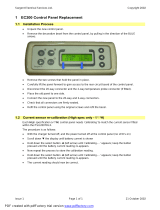
INM MTL 130-0202 Rev 4
13
5 CALIBRATION
5.1 General notes
Provided the katharometer does not become contaminated, instruments can be expected
to hold their calibration repeatability to better than 0.02% hydrogen for a lengthy period.
Chlorine accuracy varies according to air and hydrogen concentrations. In the 90 to 100%
range it is approximately 0.5% going out to about 1.5% at lower concentrations with high
hydrogen. If the ratio of oxygen to nitrogen varies then a small error is introduced into the
chlorine measurement. For every 1% oxygen variation the apparent chlorine concentration is
changed by 0.07% (higher oxygen gives higher chlorine).
5.2 Gases required
To avoid the need to handle hazardous gases, calibration may be performed using benign
surrogate gases. The surrogate gases used are; 1.5 - 2% hydrogen in air (50% LEL mixture)
as a substitute for hydrogen in chlorine, and 100% argon in place of chlorine.
Another, even more convenient, way to calibrate the chlorine span of the analyser is to
use the process sample gas - assuming its composition is reliably known from other forms
of analysis. Configuration Screen 4 (see configuration diagram in section 3), allows both
the chlorine and hydrogen concentrations (see following Note) to be set for the gas used
for calibration. For example, if the process sample analysis was 96% chlorine and 0.3%
hydrogen, this is what would need to be entered in Configuration Screen 4.
NOTE
The hydrogen concentration set in Configuration Screen 4 is to enable the analyser to
compensate for its presence when calibrating the chlorine span on process sample – it is
NOT a part of calibrating the hydrogen span. The latter is performed using hydrogen in
air and specifying the hydrogen concentration in Configuration Screen 3. The hydrogen
concentration set in Screen 4 must be zero if pure gases (i.e. 100% chlorine or 100%
argon) are used to calibrate the chlorine span.
The calibration process must be performed in the order of
1. Zero calibration (air)
2. Hydrogen span (2% hydrogen in air)
3. Chlorine span (100% chlorine, or 100% argon or process gas if analysis is known)
Air is the ‘zero’ gas, and is common to both surrogate and non-surrogate calibration
processes. It is possible to calibrate using both surrogate and non-surrogate gases. So it is
possible to zero on air, set the hydrogen span using hydrogen in air, and then set the chlorine
span using either pure chlorine or argon, or the process gas if its analysis is reliably known
and the hydrogen and chlorine concentrations are entered as described above. For best
accuracy, pure chlorine should be used for setting the chlorine span.
NOTE
Hydrogen in chlorine mixtures can only be generated on-the-spot because they are unstable.
Outside of the laboratory the practical difficulties of making these mixtures rule them out of
being used.
continued on next page
4.3.2 Edit mode
To edit a value, start by pressing the View button to enter the screen choice level. Use the
arrow buttons to step through each screen and its options. At the chosen parameter, press
the Edit button at which point the following screen is displayed.
This is to warn that all outputs will be stopped at their current value if the user goes further.
Before continuing, the operator must be sure that no plant malfunction or safety problems
will occur due to the ‘freezing’ of the analyser outputs.
When Edit mode is entered, a flashing cursor will appear on the first digit that may be altered.
The keys increment or decrement the digit. Once a digit is correct the next digit is selected
by pressing the Edit key, and so on, until the final digit. To skip a digit, press the Edit key
twice. When the Edit key is pressed on the final digit the display will show “Storing Data”
momentarily and then return to view mode, displaying the new parameters and un-freezing
the outputs.
If no keys are pressed for any 30 second period while in Edit mode an automatic time-out
takes the instrument back into measurement mode and displays a screen to this effect. Any
changes made during Edit mode prior to this are ignored and lost.
NOTE
When setting alarms the maximum hysteresis that can be set is 20% of the span of the
particular channel. It is important not to set the hysteresis to a level greater than the alarm
point otherwise the alarm will never reset.
The following is a summary of the function of the keys when in View and Edit modes.
View mode (block cursor not displayed):-
return to the previous parameter or screen
advance to the next parameter or screen
View exit View mode and return to Measurement mode
Edit displays warning screen - press again for edit cursor. See below
Edit mode (block cursor displayed):-
increment the digit under the cursor
decrement the digit under the cursor
View exit Edit mode - return to View mode
Edit advance to the next digit - or store entry (if the last digit has been changed)
and return to View mode





















